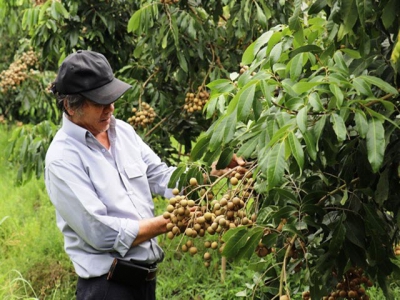Tây Ninh encourages safe and high-quality farming

Ho Chi Minh City — Tây Ninh will zone around 17,000ha of land to orient farmers and solicit investments by enterprises in producing safe and high-quality agricultural products, according to the province People’s Committee.
A longan orchard in Tây Ninh Province. — VNS Photo
Trần Văn Chiến, its vice chairman, said growing fruits trees with high economic value such as durian, pomelo, longan and custard apple, and vegetables and producing quality seedlings would be a priority.
The province would earmark funds for developing irrigation and drainage systems and adopt a number of preferential policies to encourage a shift to high-value plants, he said.
According to the local Department of Agriculture and Rural Development, after five years of implementing the Government’s decision to restructure the agricultural sector to improve value addition and ensure sustainable development, the province’s agricultural sector has achieved remarkable changes.
Its agricultural, forestry and fisheries production has increased significantly and quality has greatly improved, it said.
Last year it was worth nearly VNĐ26 billion (US$1.1 million), a 9.8 per cent increase from 2013, and helped improve the incomes and living standards of farmers.
The province has switched from traditional crops yielding low incomes to fruit trees, it said.
The area under low-value rice crops has reduced by 8,100ha to 147,800ha in the period, while the area under sugarcane and rubber has also shrunk significantly.
The area under cassava has increased from 45,658ha to 55,940ha and fruit orchards from 15,610ha to 20,212ha, with the latter mainly being fruits appropriate for local weather and soil conditions such as longan, custard apple, grapefruit, durian, mango, banana and jackfruit, which offer three or four times the value addition of other traditional crops.
The livestock sector has developed rapidly with the air-conditioned ventilated, large-scale, and closed breeding farm models growing significantly.
Livestock and poultry breeding farms following concentrated industrial and semi-industrial models account for over 60 per cent of the total of 1,349 farms in the province.
The livestock sector, besides focusing on the domestic market, has also begun to export.
The province pays close attention to developing safe agriculture, and more than 5 per cent of farm produce and animal products such as rice, vegetables, melons, fruit trees, chicken and pig meet VietGap and GlobalGap standards, bringing higher profits to farmers and enterprises, the department said.
Linkages between farmers and enterprises within and outside the province have developed strongly, with consumption of 1,500ha of rice, over 15,000ha of sugarcane, nearly six million poultry birds and over two million pigs and dairy products from nearly 2,000 cows guaranteed annually.
The province earned $13.3 billion from exports in the past five years, of which agricultural exports accounted for $2.6 billion
Có thể bạn quan tâm
 Developing hi-tech agriculture in upland areas
Developing hi-tech agriculture in upland areas Hi-tech agricultural production is quite familiar to delta regions but still strange to people in the mountainous area of Son Dong (Bac Giang province)
 China consumes 98% of Vietnamese longan output
China consumes 98% of Vietnamese longan output Vietnamese longans have been shipped to many countries in the world, most of them to China which consumed 98% of the total output.
 The efficiency from the model of passion planting in Tan Vinh commune
The efficiency from the model of passion planting in Tan Vinh commune This model opens up a new direction in changing the crop structure of the people living here.